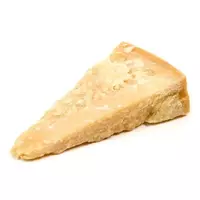Parmesan cheese

Italian hard cheese, which has a brittle grainy-scaly structure and is called Parmigiano Reggiano in its homeland, is known in Russia as Parmesan cheese. He has held the proud title of King of Cheeses for centuries. Interestingly, cows that provide milk for the subsequent manufacture of this product feed only on a certain type of grass. Moreover, milking animals and processing their milk is allowed exclusively by hand.
According to Italians, for more than 8 centuries the rules for making Parmesan cheese have not been violated. This expensive product is made from whole cow's milk necessarily 2 separate docks. The maturation times of Parmesan cheese can last for years, and the finished product must meet strict requirements: have a certain size and weight. The calorie content of Parmesan cheese is 392 kcal per hundred grams of product. It features a sweet fruity aroma and a yellow-orange color. Real cheese of this variety can be stored in the refrigerator for several months, and in the freezer even longer.
Unlike other types of cheese, this exquisite product will not be able to be cut into neat plates using the usual knife. Usually parmesan cheese is broken off in irregular pieces using a special small pedicle, which has a sharp end and a rounded handle. In grated form, it is customary to add it to vegetable salads and sprinkle almost all varieties of risotto and pasta. Without Parmesan cheese, some types of pizza simply don't exist.
Before baking, many hot vegetable and meat dishes are also sprinkled with parmesan cheese, resulting in a mouth-watering crust. By the way, in some recipe guides there is even such a trick, which is called "a la parmesane. " Another original way is to add grated parmesan to regular breading, and then roll portions of meat or fish in it and fry.
Parmesan cheese dishes work perfectly with red and white wine. This is probably why it is often used as an independent accompaniment to this drink, including at various tastings.
The Benefits of Parmesan Cheese
In addition to the high nutritional value and calorie content of parmesan cheese, its beneficial properties are also well known. First of all, it is a source of natural protein and has all essential amino acids in its composition. All this speaks in favor of Parmesan cheese.
The rich vitamin complex and the presence of vital minerals also prove the benefits of parmesan cheese for the human body. In addition, butyrylic acid in its composition contributes to the breakdown of fatty acids.
Parmesan cheese 392 kCal
Energy value of parmesan cheese (Ratio of proteins, fats, carbohydrates - ju):
Proteins: 35.75 g (~ 143 kCal)
Fats: 25.83 g (~ 232 kCal)
Carbohydrates: 3.22 g (~ 13 kCal)
Energy ratio (bj | y): 36% | 59% | 3%
 Español
Español Français
Français Português
Português Русский
Русский 简体中文
简体中文 繁體中文
繁體中文 日本語
日本語 한국어
한국어 العربية
العربية Türkçe
Türkçe Қазақ
Қазақ Deutsch
Deutsch Italiano
Italiano Українська
Українська
